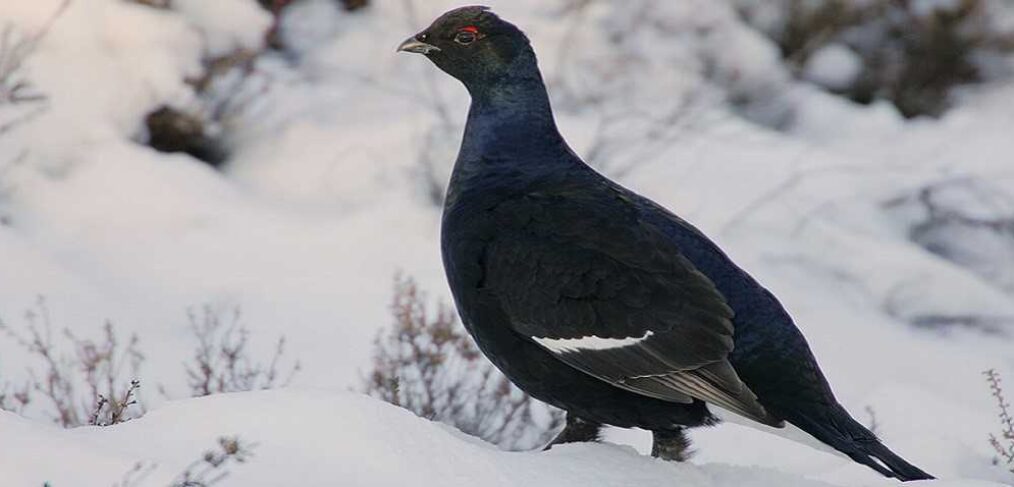
species of the week #61 – black grouse
The black grouse was once widespread in barren areas and even breeds at altitudes between about 1500 and 2200 metres. In Germany, there are still populations in the Rhön, in the Lüneburg Heath, in the Bavarian Forest as well as in the foothills of the Alps and in the Alps. However, their population is in sharp decline.
| distribution status | Extinct in Rhineland-Palatinate |
| Remaining deposits | Lüneburg Heath, Rhön, Bavarian Forest, Pre-Alps, Alps ca. 850 – 1,300 breeding pairs |
| Last sightning in rhineland-palatinate | 1994 |
| Habitat | High altitude, moors, steppes |
| Threat | Biotope fragmentation, moorland damage, tourism |
The black grouse belongs to the subfamily of grouse and is one of the most beautiful of our native birds. It is about the size of a domestic chicken. While the females wear a brown-beige plumage, with which they are excellently camouflaged, the males are conspicuous by their iridescent blue-black colouring and have a white spot and a stripe on each wing. Above the eyes, the so-called roses stand out: two bright red thickenings that look like two bushy red eyebrows in adult black grouse. All in all, black grouse resemble capercaillies, but they are much smaller. Black grouse are adapted to living in harsh climates. Their plumage also protects them against grim cold and even covers their legs.
March and April is courtship season for black grouse. The courtship display is a magnificent spectacle. The black grouses either mate alone or in groups of five or more. In the past, when there were still many black grouses, it is said that up to 50 animals performed their courtship dance at the same time. The aim is to attract the females’ attention with the most unusual movements and sounds: they blow and hiss, roll and gurgle. Some of them jump up to one metre in the air every now and then.
In winter, black grouse create snow caves they have dug themselves, in which they spend the nights, but also very cold days, to be protected from the cold. They then spend up to 22 hours in this burrow and only leave it in the early morning to feed briefly.
Black grouse are birds that are loyal to a particular place. Once they have conquered a territory, they live there for many years. Because they like sparse, varied habitats, black grouse are found in moorland and heathland, such as in the Rhön. Because many moors have been drained in order to use them for agriculture, black grouse are finding fewer and fewer suitable habitats in our country. The abandonment or change of use of alpine pastures, human disturbance and habitat fragmentation further reduce their habitat. In the Bavarian and Upper Palatinate Forest, efforts are being made through habitat optimisation and visitor guidance to improve connectivity with the small Czech population and to re-establish the black grouse in the area of the former border strip in the long term.
The protection of black grouse by granting exemptions to shoot predators in black grouse habitats should be viewed critically. This is because the main problem is not predators, but the reduction and monotonisation of biotope areas and human use.
Politically necessary:
- Extensive conservation and networking of biotope structures, including more targeted use of subsidies.
- Separation of winter habitats and winter sports
- Definition of comprehensive, verifiable and concrete conservation objectives in the Natura 2000 sites.
Click here for more exciting species of the week
Photo by Steve Garvie from Dunfermline, Fife, Scotland – Black Grouse (Tetrao tetrix) Male, CC BY-SA 2.0, https://commons.wikimedia.org/w/index.php?curid=11461073
